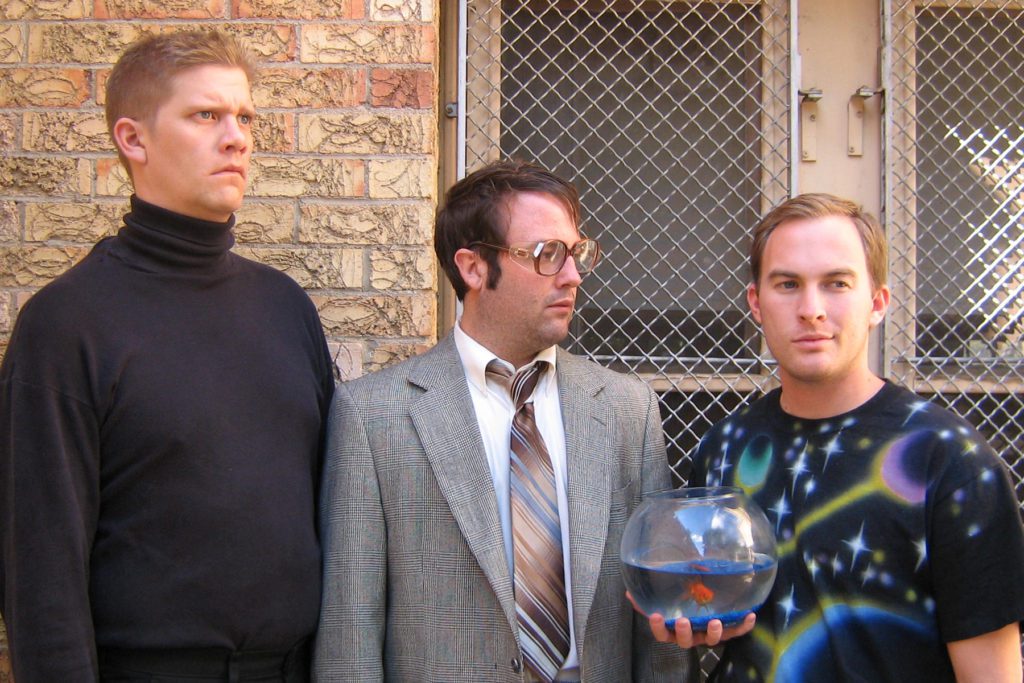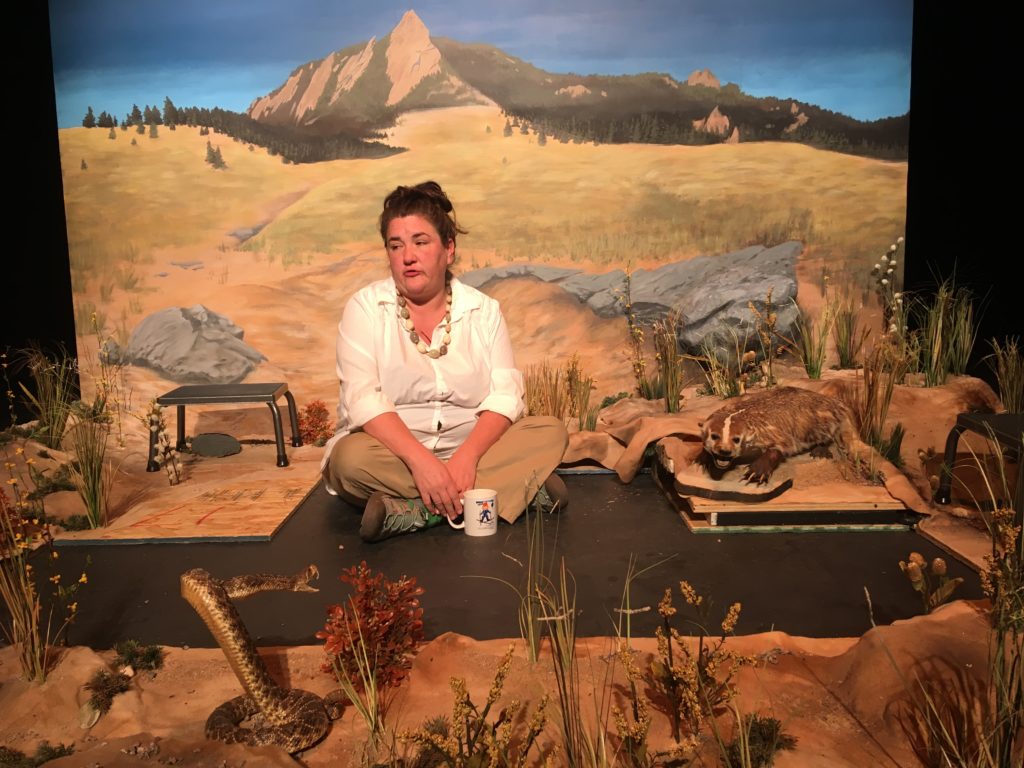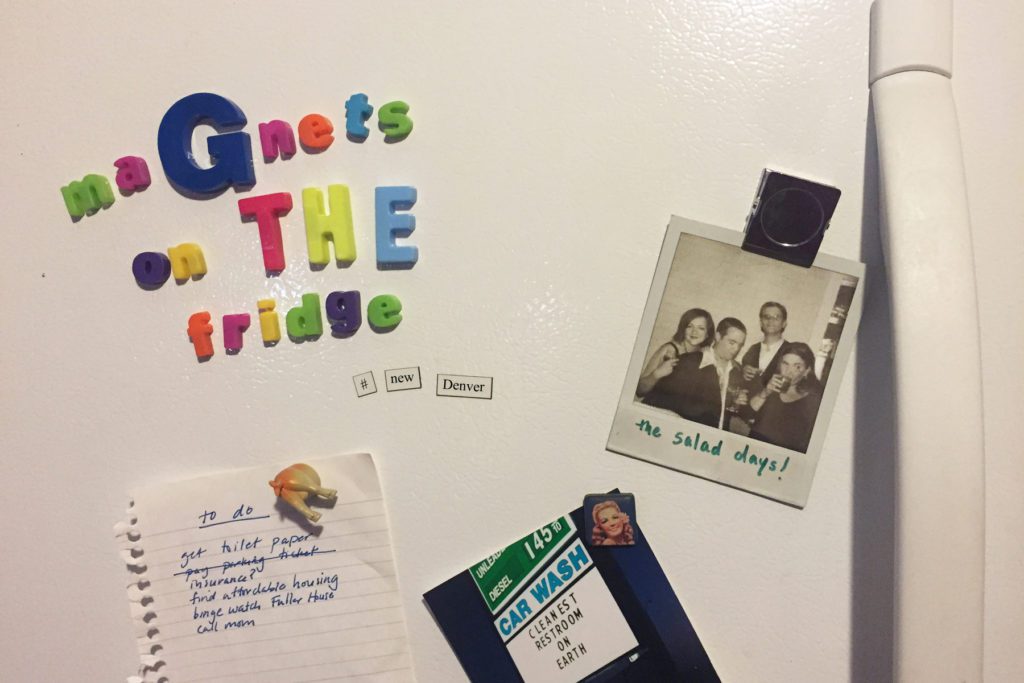There’s no point trying to make linear or literal sense of Buntport Theater’s latest offering, Coyote. Badger. Rattlesnake. While
that’s true of many of the troupe’s plays, this one skitters even more
blithely than usual into absurdist territory and beyond into the ether.
The action takes place in and around a museum diorama featuring the landscape of North America’s Great Plains. Dead center on the set is a large, flat, square picture; on the floor in front of it are puzzle pieces of the same terrain, holding dry grass, rocks and pebbles, along with a rearing rattlesnake and a badger. The badger’s name is Mitchell. The coyote, Cecily, isn’t immediately in evidence, though she shows up later. Sort of.
Glenn and Carroll, played by Brian Colonna and Hannah Duggan,
respectively, are in charge of maintaining the exhibit. They have
feelings about the taxidermied wildlife, as well as philosophical
thoughts about the nature of reality, the way we live in reality and the
ways we mimic it. They deplore the fact that nature and animal life are
reduced to dioramas like the one they’re working on, with labels and
notes that don’t begin to convey the wonder and complexity of the real
thing — though I don’t think either of them would use the words “wonder”
and “complexity.” They don’t necessarily agree on any of those
concepts, and they disagree particularly over anything that smacks of
anthropomorphism. Because the badger and the coyote hunt together, Glenn
thinks of them as “buddies.” Carroll rebukes him for that word, though
her own feelings about Cecily are strong and complex.
Erin Rollman and Erik Edborg are the stagehands: Not museum employees, but Buntport’s stagehands, which means they occupy a different reality entirely from that of Glenn and Carroll. They put pieces of the exhibit in place, sometimes messing things up, and they, too, are engaged in philosophical argument.
Watching, I couldn’t help comparing the Buntporters’ eccentric,
sometimes blade-sharp humor with other recent and less successful
attempts at comedy where you could see the actors working for their
laughs. The four performers here are at the top of their game,
functioning brilliantly as an ensemble, and also — and I think this is
crucial — never trying to be funny because they’re so immersed in the
(unreal) reality of the events they’re living through.
At the
beginning of the play, for example, Carroll is very angry. She believes
Glenn brought in the bagel from which rose an insect infestation that
destroyed much of Cecily’s face. Duggan has proved many times that she’s
a genius at every kind of rage: repressed or volcanic, sullen or
explosive, but this role allows her greater range than she’s had before.
The character is not just terrifying, she’s also vulnerable and
complicated; she feels the crazy things she feels very deeply, and there
are hints now and then of a passionate empathy — if not for actual
humans, then at least for the mummified animals of the diorama.
Colonna’s Glenn isn’t cowed, however. His responses are perfect, whether
he’s wry, puzzled, momentarily defensive, tuned out or, in a
fantastical re-enactment, describing the sad death of Mitchell the
badger. Rollman and Edborg hold their own, even though they’re working
in half-darkness a lot of the time. Rollman bustles around and uses bits
of scientific knowledge to boss Edborg and put him down while he, tall,
quiet and kindly, holds the moral high ground.
For this production, the Buntport five (the fifth is SamAnTha Schmitz, who helps create the plays and takes care of tech during performances) worked with an outside artist, playwright Ellen K. Graham. I’ve seen absurdism in Graham’s previous work, though perhaps nothing quite as fanciful as this, and I tried to recognize her influence here, to figure out if there was some difference with Coyote. Badger. Rattlesnake. from Buntport’s usual tone and focus. I thought I sensed a bit more briskness and sharpness to the dialogue, perhaps less repetition — a kind of whizzing quality — but all of that can also be seen as Buntportian. It would have been so much fun to be a fly on the wall and watch these astonishing talents lay out their collective vision and somehow fuse it. But as it is, just sitting in the audience for this hilarious, ridiculous and brilliant piece of theater is enough.
Juliet Wittman, December 4, 2018, Westword





